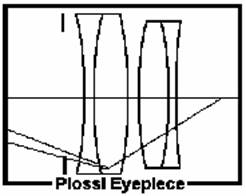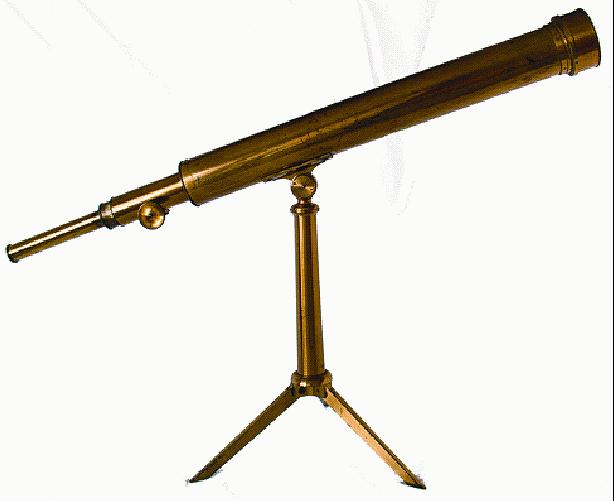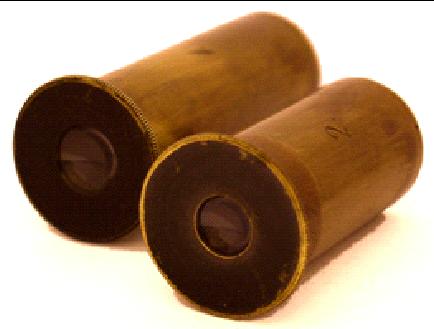The Good Old Plossl Eyepiece
Jack Kramer
Many of you have a Plossl in your collection of eyepieces; it's one of the most common types in use by amateur astronomers. In fact, some of you may have a Plossl and not even know it!

For some reason, the Plossl ocular disappeared for almost a century before it was finally revived in the 1960's. This has led some to a mistaken notion that it's a relatively new design. Georg Simon Plössl, who gave his name to the eyepiece, was born in 1794 near Vienna. He worked for the Voigtlaender optical firm, but in 1823 founded his own workshop. His main interest was improving the quality of microscope objectives and eyepieces. His microscopes were similar in design to those made in Germany by Kellner (also of eyepiece fame). In addition, Plössl made special optics - he offered diamond and sapphire lenses for use in microscopes. But he also made telescopes of a so-called "dialytic" type. His largest scope was a 101/2" refractor with a focal length of 111/2 feet, and he made several other instruments of various diameters.
The pure Plossl eyepiece design has four elements arranged as two sets of paired (achromatic) lenses. This is a variation of the Kellner, which has one achromat plus a simple lens (the achromat being the eye lens in the Kellner type I). The Plossl was also called a Kellner Type III in some earlier references; in the 1950's, Edmund Scientific sold a "Kellner" eyepiece made from war surplus lenses, but it actually consisted of two achromats in the classic Plossl configuration. The Plossl has good color correction plus is free of the ghost images that plague the Kellner. It also has a wider field of view, but in order to attain this, some pincushion distortion is allowed at the edge of the field. Thus a Plossl is not strictly "orthoscopic" in the generic sense. Premium Plossls, such as those by Tele Vue and ClavJ, provide images with less distortion than other brands through the use of better optical glasses. The Tele Vue Plossl also uses concave external lenses, rather than the usual convex elements. According to Tele Vue, "Such a lens configuration provides a significant improvement in the correction of astigmatism and coma at the edge of the field. This results in a sharper image for large field angles with a relatively small undercorrected field curvature."
To some extent, all eyepieces could offer a wider field of view, but it would be at the cost of an annoying amount of distortion at the edge of the field. So a field stop, or diaphragm, is incorporated into the eyepiece barrel. This limits the size of the field to an area in the center with the least amount of distortion. Another way to deal with distortion is to add an additional lens element that acts as a "field flattener". Current variations of the Plossl design with a fifth element are known by other names, such as Celestron's "Ultima" and Orion's "Ultrascopic". The five-element design variant is technically designated as a "Masuyama". When Meade first introduced the "Super Plossl", they too incorporated a fifth element, but they have since reverted to the classic four element design. (Nonetheless, Meade still refers to these as "Super" Plossls.) Regardless of what these eyepieces may be called by their distributors, they all have an apparent field of view around 50o.
To attain the shorter effective focal lengths (higher magnification), a few include an additional field lens that acts as a built-in Barlow. This is the route taken by the Orion Ultrascopic. So there are a lot of eyepieces in different guises and under a variety of names which essentially use the basic Plossl design. I suppose one could argue that the addition of lenses means it's no longer a "Plossl" in the strict sense.
The two original Plössl eyepieces shown here date from the late 1830's, and were included with the 21/4 inch telescope. Typically, the barrels are made of lacquered brass.
The optical inventors Kellner and Plössl were contemporaries; Kellner was born 32 years later than Plössl, but died very young in 1855. Plössl died in 1868 following an injury caused by dropping a sheet of glass, which cut the artery near his right hand, resulting in blood loss and gangrene. In 1875 a small street in Vienna was named after him. The business continued as "Fa. Ploessl & Co." until 1905. Despite his focus on the production of microscopes, today the Plössl name is best known for eyepieces.
Both these classic eyepieces have been around for a long time. Kellner released his design in 1849, while Plössl's improvement on it followed in 1860. It was not until 1880 that the first true orthoscopic (distortion-free) eyepiece was designed by Ernst AbbJ...but that's another story.
Ref: Some information for this article is from the monograph "Evolution of the Astronomical Eyepiece" by C.J.R. Lord on the Internet at: http://www.brayebrookobservatory.org/BrayObsWebSite/BOOKS/EVOLUTIONofEYEPIECES.pdf
The photographs are courtesy of Timo Mappes of the University/Research-Center of Karlsruhe, Germany.
Regarding the spelling of Plössl's name, Mappes points out that there are several acceptable versions. On the telescope pictured in this article, his name is engraved as S.Plößl in Wien; the "ß" is a letter only appearing in the German alphabet, also written as a double "s" - "Ploessl", "Plössl" or "Plossl".
As is well known in the art, a Plossl type eyepiece is a relatively wide field eyepiece comprising two achromatic doublets in which the crown elements usually face each other. Such eyepieces are capable of good performance, i.e., acceptable degrees of aberrations, to about a 50.degree. field. Generally, in order to minimize aberrations at the exit pupil and distortion, all air glass surfaces of the eyepiece are made convex. However, there have been Plossl type eyepieces used commercially in astronomical instruments in which the external flint surfaces are plano.
GENERAL DESCRIPTION OF THE INVENTION
For astronomical viewing, pupil aberrations and geometric distortions are not as important as the correction of coma and astigmatism which control image sharpness at the edge of the field.
Accordingly, it is an object of the present invention to provide an improved Plossl type eyepiece for use with astronomical instruments.
It is another object of the invention to provide a Plossl type eyepiece having improved coma and astigmatism aberrations at the edge of the field of view.
In carrying out the invention, there is provided a symmetrical eyepiece comprising two achromatic doublets in which the external surfaces of the flint elements are concave. Such a lens configuration provides a significant improvement in the correction of astigmatism and coma at the edge of the field. This results in a sharper image for large field angles with a relatively small undercorrected field curvature."
Published in the December 2003 issue of the NightTimes






